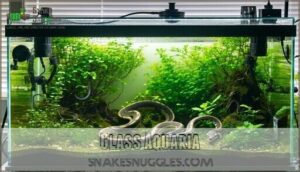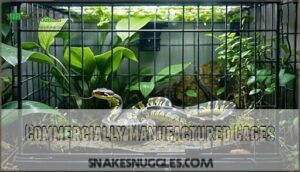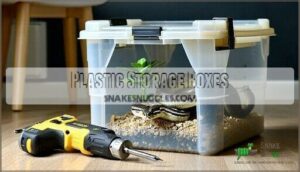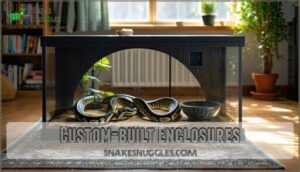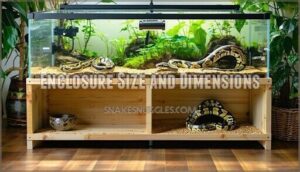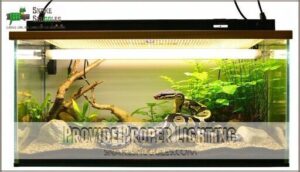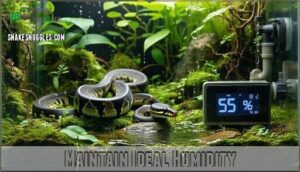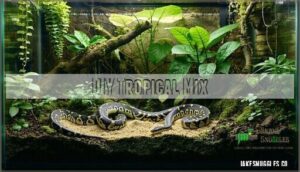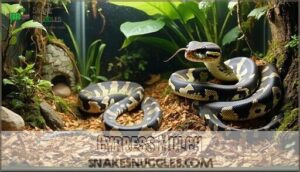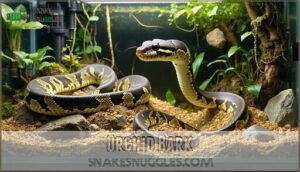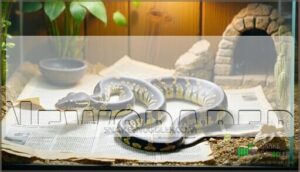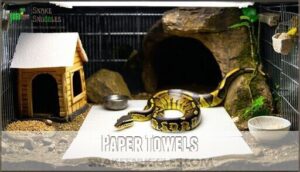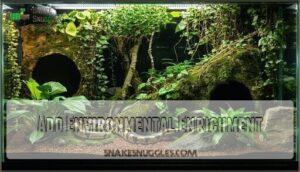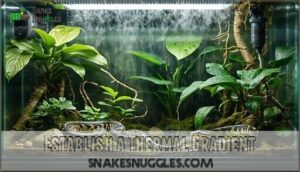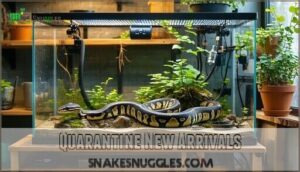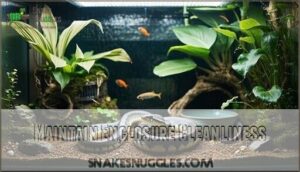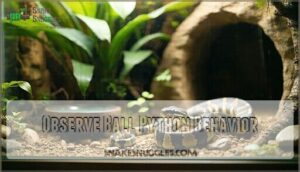This site is supported by our readers. We may earn a commission, at no cost to you, if you purchase through links.
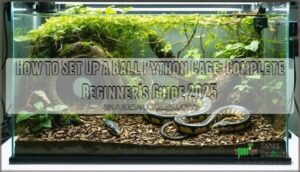
Maintain a thermal gradient with a basking spot around 88-92°F and a cool zone at 75-80°F using a heat mat or ceramic heater controlled by a thermostat.
Keep humidity at 50-60%, bumping to 70% during shedding, and use substrates like cypress mulch or paper towels for easy cleaning.
Add two snug hides, a water bowl, and optional climbing branches, thinking of it as designing a cozy studio apartment—just snake-sized, and consider ideas for enrichment.
Table Of Contents
- Key Takeaways
- How to Set Up a Ball Python Cage?
- Choose The Right Enclosure
- Provide Proper Lighting
- Maintain Ideal Humidity
- Select The Best Substrate
- Add Environmental Enrichment
- Establish a Thermal Gradient
- Quarantine New Arrivals
- Maintain Enclosure Cleanliness
- Observe Ball Python Behavior
- Frequently Asked Questions (FAQs)
- How do you set up a ball python cage?
- How do I set up a ball python habitat?
- Is a rack system necessary for a ball python cage?
- What should be the width of a ball python cage?
- How do I choose a ball python enclosure?
- What does a ball python need in its cage?
- Can you leave a heat lamp on 24/7 for ball python?
- What not to do with a ball python?
- What should a ball python habitat look like?
- How should I set up my ball python enclosure?
- Conclusion
Key Takeaways
- You’ll need a properly sized enclosure – Use at least a 40-gallon tank (48"x24"x24") for adults with secure latches and an escape-proof design to house your ball python safely.
- Create a thermal gradient with controlled heating – Maintain basking spots at 88-92°F and cool zones at 75-80°F using heat mats or ceramic heaters with thermostats to prevent overheating.
- Maintain humidity between 55-65% – Use substrates like cypress mulch or coconut fiber, position water bowls near heat sources, and monitor with digital hygrometers to support proper shedding.
- Provide essential furnishings and enrichment – Include secure hides on both warm and cool sides, climbing branches, and environmental enrichment to encourage natural behaviors and reduce stress.
How to Set Up a Ball Python Cage?
Setting up a ball python cage setup requires careful planning before your snake arrives home.
You’ll need a properly sized reptile enclosure with secure latching, temperature gradient from cool to warm zones, humidity control around 50-60%, appropriate substrate, and hiding spots.
This snake habitat foundation guarantees superior reptile health and pet safety from day one.
A well-designed enclosure also requires understanding of temperature gradient principles to create a healthy environment.
Choose The Right Enclosure
Your ball python’s enclosure serves as its lifelong home, so you’ll need to select the right type and size to guarantee proper thermoregulation and security.
A ball python’s enclosure is its sanctuary—choose wisely to ensure comfort, safety, and optimal thermoregulation for a thriving pet.
Adult ball pythons require a minimum 40-gallon terrarium with dimensions of at least 48" x 24" x 24" to accommodate their 3-5 foot length and natural behaviors.
Glass Aquaria
Glass aquaria make excellent ball python cage setup options for beginners. These transparent enclosures offer superior visibility while maintaining proper humidity levels.
Cover three walls with opaque material to create security for your snake.
- Glass Types: Choose non-tempered glass for drilling flexibility
- Aquaria Care: Clean weekly to prevent bacterial growth
- Water Quality: Maintain proper humidity without oversaturation
- Aquarium Safety: Guarantee secure, escape-proof lids
- Glass Maintenance: Regular cleaning prevents mold formation
For best results, consider the temperature gradient settings.
Commercially Manufactured Cages
Commercially manufactured cages offer the gold standard for python cage setup.
These purpose-built enclosures eliminate guesswork with professionally designed ventilation systems and secure latches that prevent escapes.
Built from tested cage materials, they provide reliable ball python habitat solutions.
Consider these key advantages:
- Escape proofing – Industrial-grade locks keep your snake secure
- Ventilation systems – Engineered airflow prevents humidity buildup
- Durability tests – Materials withstand years of use
- Snake cage accessories – Compatible with heating elements and hides
- Proper enclosure size – Designed for adult ball python dimensions
Plastic Storage Boxes
Budget-conscious keepers often choose plastic storage boxes for their first snake cage setup.
These DIY enclosure options require careful plastic box mods for proper box ventilation and box security.
You’ll need to drill air holes and install secure latches to prevent escapes.
While plastic durability varies, quality boxes offer excellent storage safety.
Monitor temperature closely since plastic cages retain heat differently than glass terrariums.
Custom-built Enclosures
Unlike storage boxes, custom-built enclosures let you create the perfect home for your python.
You’ll control enclosure materials, ventilation systems, and security features while matching your room’s décor through aesthetic options.
This DIY enclosure approach requires woodworking skills but delivers unmatched reptile enclosure design.
Your ball python cage setup becomes uniquely yours, blending function with style seamlessly.
Enclosure Size and Dimensions
Your ball python cage setup starts with proper dimensions.
The enclosure size should match your snake’s adult length—typically 4 feet long, 2 feet wide, and 2 feet high for adults.
This tank size provides adequate space for movement and accessories. Consider enclosure depth for climbing opportunities.
These enclosure size guidelines guarantee your snake tank size supports natural behaviors and long-term health.
For superior results, research the ball python requirements to create a suitable environment.
Provide Proper Lighting
Ball pythons don’t require specialized UVB lighting like other reptile species, but you’ll need to establish a consistent 12-hour light-dark cycle to maintain their natural behavioral patterns.
You can use basic fluorescent lighting on an automatic timer to simulate daylight hours while focusing your attention on creating the proper temperature gradient within the enclosure.
Habitat Lighting
Your ball python doesn’t need fancy lighting setups like other reptiles. Simple ambient lighting works perfectly for these nocturnal creatures. Set up a basic day-night cycle using standard fixtures, and you’re golden.
Here’s what you’ll need for proper ball python lighting:
- 12-hour light cycles using timers for consistency
- Heat sources separate from lighting (ceramic emitters work great)
- Standard fluorescent or LED fixtures for ambient lighting
- No UVB requirements unlike many reptile species
Proper snake care involves understanding temperature control methods to create a suitable environment.
Temperature Gradient
Creating the perfect temperature gradient transforms your ball python’s cage into a comfortable home.
Set up your heat sources to establish basking areas at 87-92°F and cool zones at 75-80°F.
Use heat lamp setup or heat mat for thermal control.
Monitor temperatures with digital thermometers for accurate temperature regulation.
This gradient setup guarantees proper temperature monitoring and healthy thermoregulation.
Maintain Ideal Humidity
You’ll need to maintain humidity levels between 55% and 65% in your ball python’s enclosure to support proper shedding and respiratory health.
Maintain 55-65% humidity to ensure healthy shedding and respiratory function for your ball python’s optimal well-being.
Monitor these levels with a digital hygrometer and adjust moisture through substrate selection, water bowl size, and occasional misting when needed, to ensure proper shedding.
Humidity Levels
Your ball python needs humidity levels between 50-60% for ideal health.
Position hygrometer devices on both warm and cool sides to monitor accurately.
Water bowls placed near heat sources naturally increase moisture.
Humid hideboxes filled with damp moss help during shedding periods.
Misting systems or manual spraying maintains consistent humidity control without oversaturating the enclosure environment.
Substrate Moisture
Managing substrate moisture creates the foundation for proper humidity control in your ball python’s habitat.
Your snake needs consistent moisture levels without waterlogged conditions that breed harmful bacteria.
- Substrate Depth: Maintain 3-4 inches of coconut fiber or cypress mulch for ideal moisture retention
- Water Bowls: Position large bowls on the warm side to increase ambient humidity naturally
- Misting Systems: Lightly mist substrate weekly, avoiding oversaturation that causes mold growth
Select The Best Substrate
You’ll need to choose substrate materials that maintain proper humidity levels while preventing bacterial growth and mold formation.
The right substrate depth of 3 inches allows your ball python to burrow naturally while supporting the 55-65% humidity range essential for healthy shedding cycles, which involves proper humidity levels.
DIY Tropical Mix
Your ball python’s comfort begins with the right tropical soil foundation.
This DIY tropical mix combines 80% organic soil with 20% play sand, creating ideal humidity control for your reptile tank decor.
Add dried leaf litter on top to complete your ball python habitat.
These substrate options support live plant selection while maintaining proper moisture levels in your ball python cage setup.
The quality of the tropical soil mix is essential for a healthy environment.
Cypress Mulch
Cypress mulch stands out as a premium substrate choice for ball python cage setup, delivering exceptional moisture control and humidity levels.
This natural wood chips option maintains consistent dampness without becoming soggy, creating the perfect environment for your snake’s health.
- Mulch Benefits: Superior moisture retention compared to other substrate options
- Cypress Care: Replace every 4-6 weeks to maintain high hygiene standards
- Wood Chips: Natural texture encourages healthy burrowing and exploration behaviors
- Moisture Control: Prevents excessive dryness while avoiding mold growth issues
- Humidity Levels: Consistently maintains 55-65% humidity for reptile tank decor
When setting up a ball python cage, understanding cypress mulch properties is vital for creating an ideal environment.
Orchid Bark
Orchid bark offers excellent humidity control for your ball python substrate selection.
This natural material maintains ideal moisture levels while providing comfortable burrowing opportunities.
Mix it with hemp bedding for enhanced texture and substrate depth of 2-4 inches.
Unlike reptile carpet, orchid bark creates microenvironments that support your snake’s natural behaviors during your ball python cage setup.
The quality of bark substrate products is vital for a healthy environment.
Newspaper
Newspaper substrate transforms your ball python cage setup into a budget-friendly solution.
This snake enclosure substrate choice simplifies maintenance while ensuring cleanliness.
When selecting newspaper substrate for your python cage ideas, consider these factors:
- Choose unprinted newspaper to avoid harmful ink types
- Source from reliable news sources for consistent paper quality
- Avoid editorial content with heavy printing methods
- Replace weekly for ideal substrate selection
Paper Towels
Paper towels offer unmatched convenience as ball python substrate.
You’ll appreciate their superior absorbency and simple replacement schedule.
This paper towel lining creates a sterile environment perfect for monitoring your snake’s health and waste patterns.
Key advantages of paper products for reptile care:
- Instant cleanup – spot-clean accidents immediately
- Health monitoring – easily observe urates and feces
- Cost-effective – affordable roll sizes with high sheet counts
- Towel safety – no ingestion risks unlike loose substrates
- Absorbency tests – quickly contain spills and moisture
Add Environmental Enrichment
Your ball python’s enclosure needs environmental enrichment to promote natural behaviors and reduce stress-related health issues.
You’ll provide hiding spots, climbing opportunities, and appropriate vegetation to create a habitat that encourages normal activity patterns and psychological well-being.
Hides and Shelters
Your snake needs hideout placement on both warm and cool sides for proper thermoregulation.
Rock caves, hide boxes, and shelter logs work perfectly as python hiding places. Choose snake hides that fit snugly—too spacious makes them feel exposed.
Add a humid hide near your water tubs to support healthy shedding. Quality snake dens encourage natural security behaviors.
Climbing Branches
Adding climbing branches transforms your ball python’s enclosure from basic to brilliant.
These vertical space additions provide climbing opportunities that mirror their natural behavior patterns.
- Branch Types: Choose hardwood varieties like manzanita or grapevine for durability and natural texture
- Climbing Structures: Position branches at different heights to create multiple climbing frequency options
- Tree Roots: Incorporate natural root formations alongside rock formations for varied climbing branch arrangement
Live Plants
Live plants transform your ball python’s habitat into a thriving ecosystem.
Plant species like pothos and snake plants excel in low light compatibility conditions. These selections require minimal watering tips – mist weekly and monitor substrate moisture management.
Research toxicity risks before introducing new vegetation.
| Plant Species | Soil Types | Pruning Methods | Toxicity Level |
|---|---|---|---|
| Pothos | Well-draining | Trim brown leaves | Non-toxic |
| Snake Plant | Sandy mix | Remove damaged tips | Safe |
| Spider Plant | Potting soil | Cut runners | Pet-safe |
| Peace Lily | Moist substrate | Deadhead flowers | Toxic |
Establish a Thermal Gradient
You’ll need to create a temperature range from 75-80°F on the cool side to 88-92°F on the warm basking side.
This thermal gradient allows your ball python to thermoregulate by moving between zones as needed for ideal health.
Basking Area
After setting up enrichment features, your ball python needs proper Heat Sources to thrive.
Position your basking spot at 88-92°F using heat lamps or heat mats.
This basking area becomes your snake’s personal sun sanctuary where they’ll regulate body temperature.
Temperature Control requires precise monitoring—never exceed 95°F or you’ll cook your companion.
The Thermal Gradients you create allow natural thermoregulation behavior.
- Basking lamp wattage: 50-100 watts for ideal Warmth Levels
- Substrate: Moderate depth enabling proper heat transfer
- Décor: Flat rocks, comfortable hide boxes
- Basking area size: 12" x 12" temperature gradient zone
Cool Zone
Your ball python’s cool zone provides necessary refuge from heat, maintaining temperatures between 75-80°F.
Position this area opposite the basking spot to create proper thermal gradients.
Monitor humidity levels at 50-60% using a hygrometer.
Adequate ventilation systems prevent stagnant air while preserving moisture.
Include secure hides and cool spots where your python can thermoregulate comfortably.
Quarantine New Arrivals
You’ll need to isolate your new ball python in a separate quarantine enclosure for 30-60 days before introducing it to your main setup.
This quarantine period allows you to monitor for parasites, mites, respiratory infections, and other health issues while preventing transmission to existing reptiles.
Minimalist Setup
Your quarantine ball python cage setup needs Simple Decor for easy monitoring.
Use paper towels as substrate with two Hide Boxes on warm and cool sides.
Maintain Temperature Control at 88-92°F basking, 76-80°F cool side.
Keep Humidity Levels at 50-60% with a water dish.
This minimalist setup prioritizes Snake Safety while allowing clear health observation during quarantine periods.
Monitor for Health Issues
Vigilance is your greatest ally during quarantine.
Watch for these critical health issues:
- Respiratory Issues – wheezing, mouth breathing, or nasal discharge
- Skin Problems – blisters, retained shed, or unusual lesions
- Dehydration Signs – sunken eyes or wrinkled skin
- Feeding Disorders – refusing meals or regurgitation
Early disease prevention through health monitoring protects against Metabolic Diseases and guarantees the best snake health.
Maintain Enclosure Cleanliness
You’ll need to establish a regular cleaning routine to prevent bacterial growth and maintain your ball python’s health.
Remove waste immediately when spotted, and perform thorough substrate changes and enclosure disinfection weekly to create a safe environment for your snake.
Spot Clean Daily
Spot cleaning is your first line of defense against mess and bacteria.
Remove waste, shed skin, and leftover food daily to keep your snake healthy and the enclosure tidy.
Replace soiled substrate as needed.
Here’s a quick guide:
| Task | Frequency | Tools Needed | Purpose | Tip |
|---|---|---|---|---|
| Feces Removal | Daily | Gloves, Tongs | Prevents bacteria build-up | Check corners and hides |
| Shed Skin Disposal | Daily | Hands, Trash Bag | Maintains hygiene | Look near heat sources |
| Uneaten Food Check | Daily | Tongs, Trash Bag | Avoids spoilage | Remove after 24 hours |
| Substrate Cleaning | As Needed | Scoop, Fresh Substrate | Keeps cage odor-free | Spot-clean, don’t overdo it |
| Water Dish Check | Daily | Sponge, Fresh Water | Guarantees hydration | Replace if soiled or empty |
Daily cleaning guarantees your snake thrives in a clean, safe environment.
Regular maintenance involves understanding reptile safe practices to prevent health issues.
It is crucial to follow reptile safe practices for a healthy environment.
Deep Clean Weekly
A clean snake enclosure keeps your ball python thriving.
Once a week, commit to deep cleaning for exceptional hygiene.
- **Empty the enclosure completely—hides, substrate, and décor.
- **Scrub with reptile-safe disinfectant, rinse thoroughly.
- **Sanitize and refill water bowls.
- **Replace all substrate to prevent bacteria buildup.
*Tip: Stick to your cleaning schedule to avoid health risks.
Observe Ball Python Behavior
Pay close attention to your ball python’s behavior to guarantee its enclosure setup meets its needs.
Observing feeding responses, shedding patterns, and activity levels can help you identify potential issues early and make necessary adjustments to ensure the best care for your pet, focusing on complete concepts.
Feeding Response
A ball python’s feeding response offers insight into its health and hunger cues.
Stick to a consistent feeding schedule of every 7–14 days, using appropriately sized prey items like prekilled rodents to guarantee proper snake nutrition.
Thaw frozen prey to body temperature for safe feeding. Live feeding is an option but risky—monitor closely to avoid injuries.
Prioritize food quality for peak health.
Shedding Process
When your python’s eyes turn cloudy and skin dulls, it’s shedding time!
Boost humidity (55-65%) or mist lightly to aid the shedding process.
Preshed behaviors signal the shedding cycle’s start.
Check for retained shed, especially near the tail and eyes—like peeling off an old sweater, every bit matters.
Proper humidity control guarantees smooth skin care and a healthy snake.
Understanding ball python shedding is vital for providing the right environment during this critical phase.
Activity Levels
Understanding your snake’s activity levels helps gauge its well-being.
Watch for natural behaviors like enclosure exploration and climbing branches. These activity patterns show it’s enjoying proper environmental stimulation.
A happy python may also burrow into the substrate or interact with its water bowl.
- Enclosure Exploration: Roams around confidently.
- Climbing Opportunity Provision: Uses branches often.
- Burrowing Behavior Support: Digs for comfort.
- Water Bowl Interaction: Drinks or soaks occasionally.
Frequently Asked Questions (FAQs)
How do you set up a ball python cage?
Setting up a ball python cage is like designing a cozy studio apartment.
Use a 48"x24"x24" enclosure, maintain a temperature gradient (75-92°F), and ensure 55-65% humidity.
Secure hides, and suitable substrate like aspen shavings should be provided to complete the cage setup.
How do I set up a ball python habitat?
Create a habitat with a secure 40-gallon enclosure, maintain a temperature gradient (75-92°F), and 55-65% humidity.
Add hides, a water dish, and safe substrate like aspen.
Monitor conditions with thermometers and hygrometers.
Is a rack system necessary for a ball python cage?
A rack system isn’t necessary for a single ball python.
It’s more suited for breeders managing multiple snakes.
For one pet, a spacious, secure enclosure with proper heating, humidity, and hides works perfectly.
What should be the width of a ball python cage?
Picture your ball python gracefully coiled, its cage width should be at least one-quarter of its adult length.
For a 5-foot snake, aim for a 12-inch-wide enclosure to guarantee comfort and mobility.
How do I choose a ball python enclosure?
Pick an enclosure matching your snake’s size—glass for visibility, PVC for heat retention, or wood for humidity.
Make certain it’s escape-proof, ventilated, and fits the snake’s length.
Avoid shoe boxes; they’re not snake-friendly!
What does a ball python need in its cage?
Did you know ball pythons can grow up to 5 feet?
Your snake needs a secure enclosure with proper heat, humidity, hides, climbing space, and a substrate like aspen shavings for comfort and health.
Can you leave a heat lamp on 24/7 for ball python?
You shouldn’t leave a heat lamp on 24/
Ball pythons need a day-night cycle to mimic natural conditions.
Use a thermostat to maintain nighttime temps above 70°F, turning off the lamp overnight if needed.
What not to do with a ball python?
Don’t house a ball python in a shoebox—it’s not escape-proof or ventilated.
Avoid excessive handling, as it stresses them out.
Never skip a thermostat for heat sources; overheating can harm or even kill your snake.
What should a ball python habitat look like?
Your ball python’s habitat should include a secure, escape-proof enclosure sized for its length.
A temperature gradient from 76-92°F, 55-65% humidity, and hides for security are also essential components.
A suitable substrate like coconut fiber is necessary to complete the habitat.
How should I set up my ball python enclosure?
Think of your enclosure as a cozy apartment for your snake.
Use a secure 48"x24"x24" tank, provide a temperature gradient (75-92°F), and maintain 55-65% humidity.
Provide hides, and a substrate like aspen or coconut fiber.
Conclusion
Setting up your ball python’s habitat correctly is absolutely essential for your snake’s long-term health and wellbeing.
You’ve now learned how to set up a ball python cage with proper temperature gradients, humidity levels, and enrichment features.
Remember that consistency in maintaining these environmental parameters is key to preventing stress and health issues.
Monitor your python’s behavior regularly, adjust conditions as needed, and you’ll provide an ideal home that supports natural behaviors and promotes a thriving, healthy snake.
- https://www.reptileknowledge.com/care/bp-cage-setup.php
- https://www.wilbanksreptiles.com/blogs/ideal-tank-size-for-healthy-ball-pythons/what-is-the-recommended-tank-size-for-a-ball-python?srsltid=AfmBOooWrrNKzxyWLZqkIwDtokXE1Ibh4vPyFf9iK92A5aoSsCJWI_IH
- https://ball-pythons.net/forums/showthread.php?249310-A-note-on-ball-python-cage-sizes-lessons-from-Germany
- https://reptifiles.com/ball-python-care-guide/ball-python-terrarium-size-lighting/
- https://www.facebook.com/groups/DIYReptileEnclosures/posts/27776699978641923/

